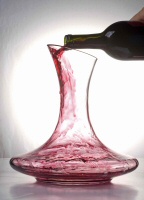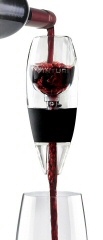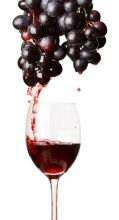|
We have all come across wines that were in need of some sort of help. For certain wines, the help could be as easy as allowing the wine to breathe. Wine is said to be alive, in that it changes chemically as it ages. But do wines actually breathe? Wine absorbs oxygen and oxidizes (inhales) and during fermentation it releases carbon dioxide (exhales). Sounds like breathing to me. Nonetheless, the breathing of wine most refers to aeration. Oddly enough, this quarter's selection of Pianetta is an example of a wine that wine needs to breathe. By allowing certain wines to breathe, you will notice an improvement both in smell and flavor. The oxygen, when it comes into contact with wine, will evaporate or volatize the esters-flavor liquids (that is why you swirl the glass before you smell). Most importantly, the aeration of wine will soften harsher tannins, thus making the wine taste better.
To Decant Or Not To Decant?
 The best way to allow a wine to breathe or to aerate is to decant the wine. Decanting is a fancy word for pouring the wine from the bottle into another container. This decanting container can be made of expensive crystal or can be a simple carafe like what Paul Masson wines came in at one time. The decanter needs to be large enough to hold the entire bottle of wine allowing the air to oxidize the wine. Pouring exposes the wine to the maximum amount of oxygen; some people even pour it back and forth between two decanters, thereby increasing the oxygen exposure. Decanting is also used to avoid consuming any bitter sediment found in older red wines. If you do not have a decanter, just pour the wine into very large wine glasses and let it stand at least ten minutes prior to consuming. The best way to allow a wine to breathe or to aerate is to decant the wine. Decanting is a fancy word for pouring the wine from the bottle into another container. This decanting container can be made of expensive crystal or can be a simple carafe like what Paul Masson wines came in at one time. The decanter needs to be large enough to hold the entire bottle of wine allowing the air to oxidize the wine. Pouring exposes the wine to the maximum amount of oxygen; some people even pour it back and forth between two decanters, thereby increasing the oxygen exposure. Decanting is also used to avoid consuming any bitter sediment found in older red wines. If you do not have a decanter, just pour the wine into very large wine glasses and let it stand at least ten minutes prior to consuming.
Which Wines Need To Breathe?
 Many red wines and a few whites will benefit from aeration. Generally speaking, young tannic red wines like Cabernet Sauvignons, Zinfandels, Bordeaux, some Rhône Valley wines and many Italian wines taste better following tannin-softening aeration. These red wines are often meant to age. If you're serving wine young, giving it some air will accelerate the aging process by oxidizing it. This will bring it a bit closer to what it might be ten years down the road, (this is one of the main reasons why people decant red wine). Additionally, some full-bodied whites will do well with some aeration. Many red wines and a few whites will benefit from aeration. Generally speaking, young tannic red wines like Cabernet Sauvignons, Zinfandels, Bordeaux, some Rhône Valley wines and many Italian wines taste better following tannin-softening aeration. These red wines are often meant to age. If you're serving wine young, giving it some air will accelerate the aging process by oxidizing it. This will bring it a bit closer to what it might be ten years down the road, (this is one of the main reasons why people decant red wine). Additionally, some full-bodied whites will do well with some aeration.
How long?
As a general rule of thumb, one hour of decanted aeration seems to be enough time for most young reds. Older red wines will change and oxidize more quickly. The older the wine is, the more fragile it will be. Do not give older reds, particularly those with a pale brick red or garnet color, much aeration.
You can try this out and see for yourself how air affects the wine and its flavors. However, make sure you taste the wine right after opening and then taste it again 15 minutes later, then another 15 and another and another. Sound like fun? You may want to try this with the Pianetta Bilancio or if you have another very tannic red--say a Cabernet Sauvignon from Bordeaux or California that's not more than one to two years old.
What's Tannin Again?
 Take a sip of strong black tea and notice that puckery sensation as it coats your mouth with an astringent fuzziness. Now take a taste of a young Cabernet Sauvignon, and chances are you'll feel a similar sensation. What you're tasting is tannin , a natural chemical that's sometimes found in tree bark, wood, and the skins, seeds and stems of some fruits - in particular some red wine grapes. Tannins are used to "tan" animal hides to turn them into leather, and that's actually the process you feel when the tannins in tea or wine start to work on the proteins inside your mouth. Think about that the next time you enjoy a youthful Cabernet! Tannins in wine come mostly from the grape skins, and additionally, oak aging may also impart some tannins. Take a sip of strong black tea and notice that puckery sensation as it coats your mouth with an astringent fuzziness. Now take a taste of a young Cabernet Sauvignon, and chances are you'll feel a similar sensation. What you're tasting is tannin , a natural chemical that's sometimes found in tree bark, wood, and the skins, seeds and stems of some fruits - in particular some red wine grapes. Tannins are used to "tan" animal hides to turn them into leather, and that's actually the process you feel when the tannins in tea or wine start to work on the proteins inside your mouth. Think about that the next time you enjoy a youthful Cabernet! Tannins in wine come mostly from the grape skins, and additionally, oak aging may also impart some tannins.
A healthy dose of tannins in a young wine can make it less than a pleasure to drink, and for this reason, certain wines - in particular red Bordeaux and other young Cabernet Sauvignons will be aged/cellared for several years so they can mature. During the maturation process, the tannins polymerize (combine into longer-chain molecules), and as a result of this process, the wine develops a bit of sediment in the bottle as its flavor evolves from harsh and astringent to mellow and complex. Tannins also act as antioxidants, naturally preserving the wine during its maturing years.
|